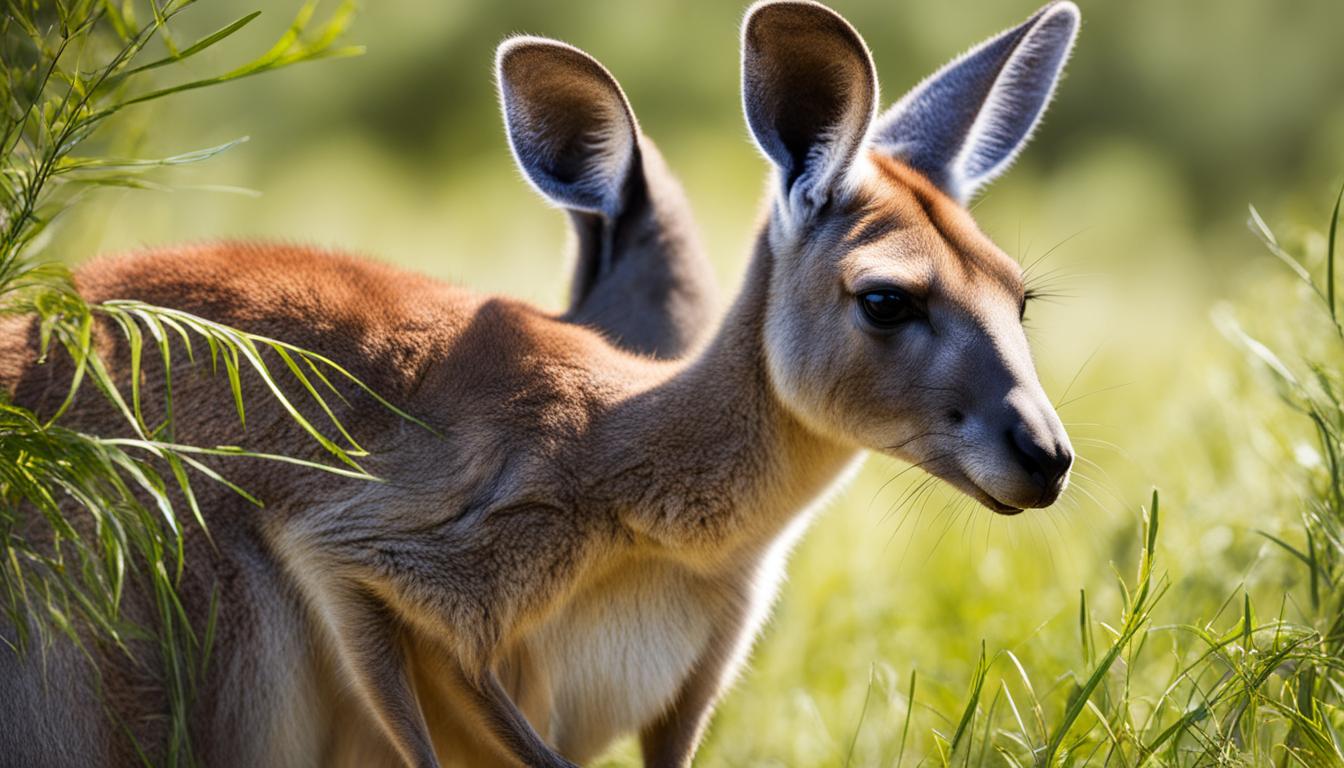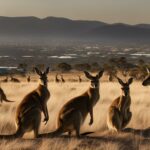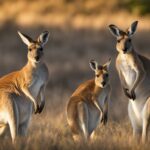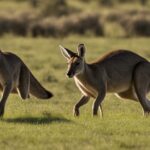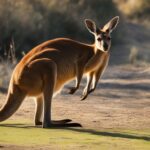Did you know that kangaroos are not only iconic Australian animals but also play a crucial role in the ecosystem? In this article, we will explore the current conservation status of kangaroo populations and the efforts being made to protect these unique marsupials.
Kangaroos are classified as “Least Concern” by the International Union for Conservation of Nature (IUCN) due to their wide distribution, abundance, and the presence of management plans. As of 2017, the estimated population of kangaroos was approximately 5.8 million individuals. Government biologists actively manage kangaroo populations, and commercial harvest quotas are in place to ensure sustainable harvests for meat and skins. However, urbanization, dingo predation, and road building pose significant threats to kangaroos and their habitats.
Stay tuned as we delve deeper into the population status, conservation efforts, and the challenges faced by kangaroos in subsequent sections. Let’s explore the fascinating world of kangaroo conservation together!
Population Status of Kangaroos
The population of kangaroos has experienced a decline over the years. In 1981, kangaroos were the most abundant of all kangaroo species, with an estimated 8.4 million individuals. However, the population estimates for kangaroos in 2017 were approximately 5.8 million individuals. This decline in population size raises concerns about the long-term conservation of kangaroos.
Commercial harvest quotas have been implemented, allowing for the killing of hundreds of thousands of kangaroos each year for their meat and skins. While these quotas are meant to be sustainable, there is ongoing debate about the impact of these harvests on kangaroo populations. Some argue that the quotas are causing further population decline, while others believe that proper management can ensure the sustainability of the harvests without endangering the kangaroo populations.
To better understand the current population status of kangaroos, ongoing monitoring and research are crucial. By accurately estimating population sizes and assessing the impact of commercial harvests, conservation efforts can be tailored to address the specific needs of kangaroo populations. This information can guide the development of effective management plans that aim to balance the preservation of kangaroos with the utilization of their resources.
Table: Comparison of Kangaroo Population Estimates
| Year | Population Estimate (in millions) |
|---|---|
| 1981 | 8.4 |
| 2017 | 5.8 |
Kangaroo Conservation Efforts and Programs
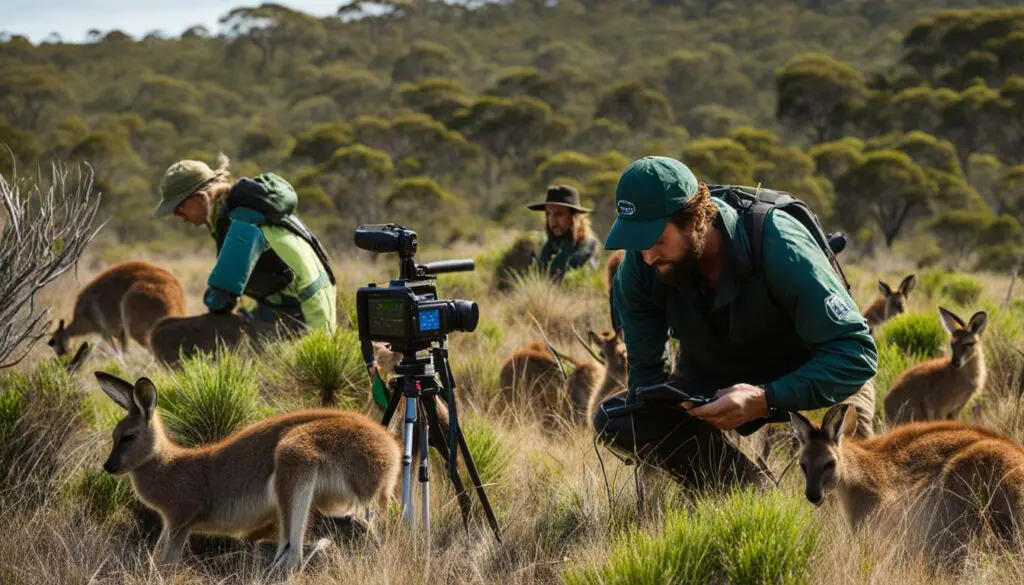
Protecting kangaroos and their habitats is a priority for conservation organizations and government agencies. Various efforts and programs have been implemented to ensure the long-term survival of kangaroo populations. These initiatives aim to address the challenges faced by kangaroos and promote sustainable coexistence with human activities.
Conservation Measures
Conservation programs for kangaroos involve a combination of scientific research, habitat protection, and population management. Government biologists work closely with local communities and stakeholders to implement strategies that balance the needs of kangaroos and human populations.
One notable approach is the establishment of protected areas specifically designed to conserve kangaroo populations. These areas provide safe havens for kangaroos to thrive and successfully reproduce. Additionally, research is conducted to gain a better understanding of kangaroo ecology, behavior, and population dynamics, which informs conservation efforts and ensures their effectiveness.
Furthermore, sustainable harvest quotas have been implemented in certain regions, allowing for the controlled harvesting of kangaroos for meat and skins. These quotas are carefully regulated to ensure that population numbers remain stable and ecological balance is maintained.
Collaboration and Public Awareness
Kangaroo conservation efforts also involve collaboration between conservation organizations, government agencies, and local communities. By working together, these stakeholders can share knowledge, resources, and expertise, leading to more effective conservation strategies and improved outcomes for kangaroo populations.
Public awareness plays a crucial role in kangaroo conservation as well. Educational campaigns and initiatives are carried out to raise awareness about the importance of kangaroos and their role in the ecosystem. By fostering a sense of appreciation and understanding among the general public, these efforts aim to garner support for conservation programs and encourage responsible behavior towards kangaroos and their habitats.
The Value of Kangaroo Protection
Kangaroos are iconic and unique marsupials that are not only important for the Australian ecosystem but also hold cultural significance. Preserving their populations and habitats is essential for maintaining biodiversity and ecosystem balance. By actively protecting kangaroos, we can safeguard the future of these incredible creatures and ensure their continued presence in the wild for generations to come.
Kangaroo Habitat Conservation and Strategies for Survival
Kangaroos, like many other wildlife species, face threats to their survival due to human activities and environmental changes. One of the key challenges is habitat destruction and fragmentation, which disrupts the natural ecosystems that kangaroos rely on for food, shelter, and breeding. Urbanization and road building are major contributors to habitat loss, as they lead to the clearing of land and the fragmentation of kangaroo habitats. As a result, kangaroos are forced to navigate through unfamiliar and potentially dangerous environments, increasing their vulnerability to predation and vehicle collisions.
To address these threats and ensure the conservation of kangaroo habitats, various strategies have been implemented. One approach is the establishment of protected areas where kangaroos can thrive without disturbance from human activities. These protected areas serve as havens for kangaroos and other wildlife, providing them with suitable habitats and ensuring their long-term survival. Additionally, conservation organizations work closely with governments, landowners, and communities to develop and implement conservation plans and regulations that promote sustainable land use practices and protect kangaroo habitats.
“We must prioritize kangaroo habitat conservation to safeguard these iconic Australian marsupials for future generations. By preserving their natural habitats and implementing effective conservation strategies, we can ensure the survival of kangaroo populations and maintain the ecological balance of our ecosystems.” – Conservationist Quote
In order to reduce vehicle collisions and protect kangaroos along roadsides, innovative solutions are being explored. These include the use of repellent sounds emitted by vehicles to deter kangaroos from approaching roads, as well as the installation of physical structures like fences and underpasses to prevent kangaroos from accessing the roads. However, it is important to note that not all of these measures have proven to be entirely effective, and ongoing research and monitoring are necessary to refine and improve these strategies.
Threats to Kangaroo Survival
In summary, kangaroos face significant threats to their survival, primarily due to habitat destruction, urbanization, and road building. The conservation of kangaroo habitats and the implementation of effective strategies are crucial in ensuring the long-term survival of these iconic marsupials. By addressing these threats and working collaboratively, we can protect kangaroo populations and preserve the unique biodiversity of our ecosystems.
Tree Kangaroo Conservation Status
Tree kangaroos, a unique species of kangaroo that inhabit trees, have been facing significant challenges in terms of conservation. The loss of habitat and over-hunting have led to severe reductions in their populations and range. One particularly endangered species is the Wondiwoi tree kangaroo, with possibly only 50 individuals remaining. Another species, the dingiso, has experienced a population decline of over 80% in the last 30 years.
Efforts to conserve tree kangaroos involve a range of strategies and initiatives. Establishing protected areas is crucial, as it provides safe havens for these endangered animals. Conducting surveys and research helps to gather valuable data on their populations, habitats, and behavior, which can inform conservation efforts. Additionally, raising awareness among local communities is essential to promote understanding and support for tree kangaroo conservation.
Tree Kangaroo Diet and Habitat
Tree kangaroos have a unique diet and habitat that sets them apart from their ground-dwelling counterparts. These fascinating marsupials primarily feed on leaves and fruit, but their diet can also include other food items such as grains, flowers, sap, eggs, and even bark. This diverse diet allows tree kangaroos to adapt to their forest environment and utilize a wide range of resources.
When it comes to habitat, tree kangaroos are predominantly found in montane tropical forests. They are distributed across Indonesia, Papua New Guinea, and Australia. These lush, dense forests provide a rich and varied habitat for tree kangaroos, with tall trees offering them both shelter and a food source. However, the ongoing issue of deforestation and the impacts of climate change pose significant threats to their habitat.
Table: Tree Kangaroo Diet and Habitat Summary
| Diet | Habitat |
|---|---|
| Leaves, fruit, grains, flowers, sap, eggs, bark | Montane tropical forests |
| Indonesia, Papua New Guinea, Australia |
In summary, tree kangaroos have a diverse diet that includes leaves, fruit, and various other food items. They primarily inhabit montane tropical forests in Indonesia, Papua New Guinea, and Australia. However, the destruction of their habitat through deforestation and the effects of climate change are major concerns for the conservation of these unique marsupials. It is crucial to address these threats and implement effective conservation measures to ensure the long-term survival of tree kangaroo populations.
Tree Kangaroo Management Actions
Various management actions have been proposed to address the declining population of tree kangaroos and protect their habitats. Conservation organizations and government agencies are actively involved in implementing programs and initiatives to ensure the survival of these endangered species. Some of the key management actions include:
- Surveys and Research: Conducting comprehensive population surveys and research studies to gather valuable data on tree kangaroo populations, their habitat preferences, and behavior. This information helps in developing effective conservation strategies.
- Conservation Education: Raising awareness among local communities, schools, and stakeholders about the importance of tree kangaroo conservation. This includes organizing educational workshops, awareness campaigns, and community-based conservation programs.
- Habitat Protection: Establishing protected areas and nature reserves specifically dedicated to the conservation of tree kangaroos and their habitats. These areas help to limit human encroachment, logging, and other activities that can lead to habitat destruction.
- Hunting Regulations: Developing and enforcing strict hunting regulations to control illegal hunting and trade of tree kangaroos. This involves collaboration with law enforcement agencies and implementing penalties for those involved in illegal activities.
- Captive Breeding Programs: Establishing captive breeding programs to ensure the long-term survival of endangered tree kangaroo species. These programs aim to breed and reintroduce individuals into their natural habitats to boost population numbers.
By implementing these management actions, conservationists and authorities strive to reverse the population decline and ensure the preservation of tree kangaroos for future generations.
| Tree Kangaroo Species | Population Decline (%) |
|---|---|
| Wondiwoi tree kangaroo | 95 |
| Dingiso | 80 |
Conclusion
Kangaroos and tree kangaroos both require conservation efforts to protect their populations and habitats. While kangaroos are currently classified as “Least Concern,” ongoing management and conservation initiatives are crucial to ensure their long-term survival. Various kangaroo conservation organizations and initiatives are actively working towards these goals.
On the other hand, tree kangaroos face more pressing challenges, with some species classified as critically endangered. It is essential to prioritize their conservation through targeted efforts. Conservation organizations and initiatives are implementing research, education, and habitat protection measures to reverse the population declines and prevent further habitat loss for tree kangaroos.
By raising awareness, conducting research, and implementing effective conservation measures, these unique marsupials can be safeguarded for future generations. The dedication and collaboration of kangaroo conservation organizations and initiatives are crucial in ensuring the continued existence of these remarkable creatures and their vital role in their respective ecosystems.
Does the Average Lifespan of Kangaroos in the Wild Impact Their Conservation Status?
The average lifespan of kangaroos in the wild directly affects their conservation status. With a lifespan of 6-8 years, kangaroos face threats such as hunting, habitat loss, and vehicles. Conservation efforts must consider their limited longevity and prioritize protection to ensure their survival in the wild.
FAQ
What is the current conservation status of kangaroo populations?
Kangaroos are currently classified as “Least Concern” by the IUCN due to their wide distribution, abundance, and the presence of management plans.
What is the population status of kangaroos?
In 2017, the population estimates for kangaroos were approximately 5.8 million individuals, indicating a decline from the estimated 8.4 million individuals in 1981.
What efforts are being made to protect kangaroos?
Kangaroos are managed by government biologists, and commercial harvest quotas exist to allow for sustainable harvests for meat and skins. Conservation efforts focus on maintaining stable populations and protecting habitats.
What threats do kangaroos face?
Kangaroos face threats such as dingo predation, urbanization, and road building, which impact their habitats and increase their vulnerability to vehicle collisions.
What is the conservation status of tree kangaroos?
Tree kangaroos face severe reductions in populations and range, with some species, such as the Wondiwoi tree kangaroo, being critically endangered.
What do tree kangaroos eat and where do they live?
Tree kangaroos primarily eat leaves and fruit but can also consume grains, flowers, sap, eggs, and bark. They inhabit montane tropical forests in Indonesia, Papua New Guinea, and Australia.
What management actions are being taken for tree kangaroos?
Conservation organizations and government agencies are conducting surveys, research, and education programs to increase knowledge and awareness. Hunting regulations, habitat protection, and captive breeding programs are also part of the efforts.
What is being done to conserve kangaroos and tree kangaroos?
Conservation organizations and initiatives are working towards the conservation and protection of both kangaroo species, focusing on raising awareness, conducting research, and implementing conservation measures.

